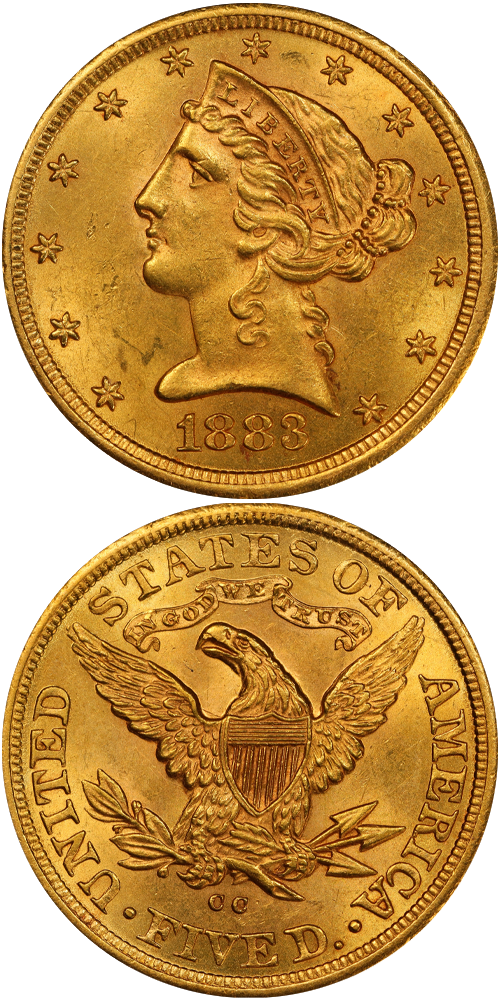1883-CC Liberty Head Half Eagle
Jeff Ambio: The obverse of the 1883-CC half eagles has a large date positioned midway between the base of Liberty's neck and the denticles. The reverse is unique among 1880s Carson City Mint half eagles in that it displays a small, round mintmark similar to that found on CC-mint fives from the 1870s. Most numismatic scholars believe that this reverse die is a leftover from the 1870s that, for some unknown reason, was put into use in 1883. This is the final issue in this series on which the small CC mintmark is found; all Carson City Mint half eagles dated 1884 and later display the large, narrow style mintmark.
Rusty Goe: A quick glance at the mintage figure table for the Carson City branch tells us that a pronounced reversal in the Treasury's policy of emitting greater numbers of smaller denomination gold coins than double eagles had occurred in 1883. This dramatic deceleration in half eagle and eagle production also happened at the San Francisco Mint that year, although its output of double eagles had remained consistently high throughout the years that the Treasury had switched to a small gold coin denomination mode. The Philadelphia Mint's output of half eagles and eagles, while diminishing in 1883, maintained relatively elevated levels. That institution did not, however, mint any business strike double eagles that year. As for gold coin production at the New Orleans branch, only 800 $10 eagles were delivered. Mint Director Horatio Burchard called the New Orleans Mint's gold coin emissions for the 1883 fiscal year (which included the last half of 1882) "inconsiderable."
Silver dollars kept the Carson Mint in business in 1883 just as they had the year before. While its output of these large coins made out of the metal that gave Nevada one of its nicknames did not approach those of the other three working mints, the 100,000 pieces it delivered monthly served the local area well. Horatio Burchard recognized this in his 1883 annual report when he said, "[The Carson Mint] is of advantage to the miners and mine owners in that portion of Nevada ... affording a local market for their silver production." Not wanting to minimize the significance of the gold side of the ledger, Burchard added, it was "a convenient means [for the locals] of obtaining the value of their gold bullion in coin or bars." Superintendent James Crawford determined in early 1883, now that the Treasury had rescinded its order for his mint to participate in the small-gold-coin-denomination-is-better plan, that his supply of half eagles and eagles was sufficient. Coiner Levi Dague waited ten months into 1883 before he struck any, delivering the first and only run of 1883-CC half eagles, 12,958 pieces, in October that year.
Collectors today have a population of perhaps one and a half to two percent of that original mintage from October 1883 from which to choose.
Q. David Bowers: Rusty Goe estimates 200 to 250 survive, with seven or eight Uncirculated. My estimates are lower. VF is a typical grade, but EF coins are easily located. At the AU level the issue is elusive." Very rare and underrated in all grades," according to David Akers, that statement no doubt based on the small mintage for the date of just 12,958 coins.
The example to the left was sold by Stack's Bowers Galleries in the August 2012 Battle Born Collection of Carson City Coinage, where it realized $44,062.






